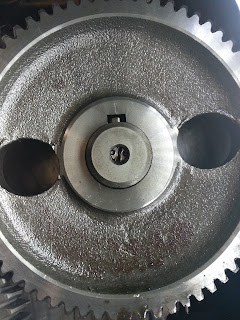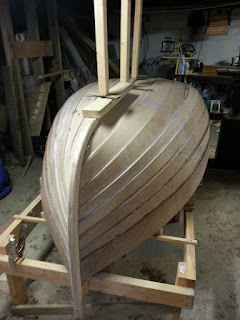The Gear Case
Removing the gear case is as simple as removing the 11 bolts around the edges. Each bolt is a different length so I made a map and labeled them as I took them out. It will make putting the right bolt back in the right place easy.
The case came off without a hitch, though some of the bolts were very tight and corroded. Thankfully none broke in the process. It would probably have been a good idea to hit those bolts that can be located on the block with PB Blaster or some other penetrating oil. I lucked out.
There is a windsor key on the crankshaft that keys the balancing pulley. I should have removed this before removing the case as the crankshaft oil seal had to pass over it. Thankfully I did not damage the seal, but I might have. Better safe than sorry. Next time.
Once the case was off, the timing gears and the oil pump were exposed. In the picture to the right the upper right hand gear is the camshaft gear. The upper left is the timing gear connected to the timing pump. The middle gear connects the crankshaft gear below to both the camshaft and the timing gear. The oil pump gear is the small gear below the crankshaft.

In order to remove the oil pump gear one must first remove the windsor key, collar and oil deflecting washer that are on the crankshaft. The windsor key is the only potentially difficult part. I tried prying it off, banging on it, vice grips, heat -- to no avail. Joe, one of my boat neighbors and retired metalworker was nearby and said that an "old timer" told him to just tap it gently a couple of hundred times with a ball peen hammer and it will eventually loosen. Then it can be removed with pliers. Joe offered to give it a try and had the key out in about five minutes. Yes, I felt rather stupid but was pleased to learn this trick. I have a plastic headed hammer that I use to bang on metal, especially aluminum, so I don't damage it. If you are using a ball peen be careful not to damage the key too much or you will wind up replacing it. Once the key is removed the collar, o-ring and large washer come off easily. Now you are ready to pull the oil pump gear.

There is a nut on the oil pump shaft and a soft, bent lock washer that must be removed before the gear will come off. A small gear puller makes removing the gear easy. It is just on a tapered shaft. As with the crankshaft pulley start gently until you feel the gear start to come off. Once this gear is removed the oil pump will unbolt with four bolts in the the corners. The original pump had 3 bolts that attached the two parts of the pump housing together. The replacement pump had only one. In any case, there is a small, shallow cylindrical extrusion on the back center of the pump that positions the pump in the block. This is a very tight fit and required a bit of tapping around the edges to spin the pump loose from the gasket. Once the pump is removed all that is left is to scrape off the gasket and clean the block, add the new gasket, making sure the holes all line up and bolt on the new pump. I have no idea what the torque specs are on these bolts so I tightened them as much as I dared. Aluminium threads strip easy.

You may recall that I thought the cause of my low oil pressure was the camshaft plug coming out of the end of the shaft. As you can see on the image to the left, the plug is still in place. This was worrying. Additionally I could see no visible wear on the old oil pump so perhaps all this was in vein.
There is a plug on the other end of the camshaft and I spent some time asking around to see if anyone had removed their camshaft and how it was attached at the other end. It looked like a big job, with the header and rocker arms having to come off so all the valves could be raised to create enough clearance for the shaft to come out.
Having just spent about 4K on the boat over the summer I really did not want to undertake the expense of paying a mechanic to remove the shaft. If I had the engine out and sitting on the bench it would have been a piece of cake and I would not have hesitated to give it a try. So I dithered and dwelled on the problem for a couple of weeks. In the end I decided that I had spent enough money on the boat this year and would just reassemble the case and deal with it in the spring. This was frustrating. Oddly, I would have been happier if the damn camshaft plug was missing!


























